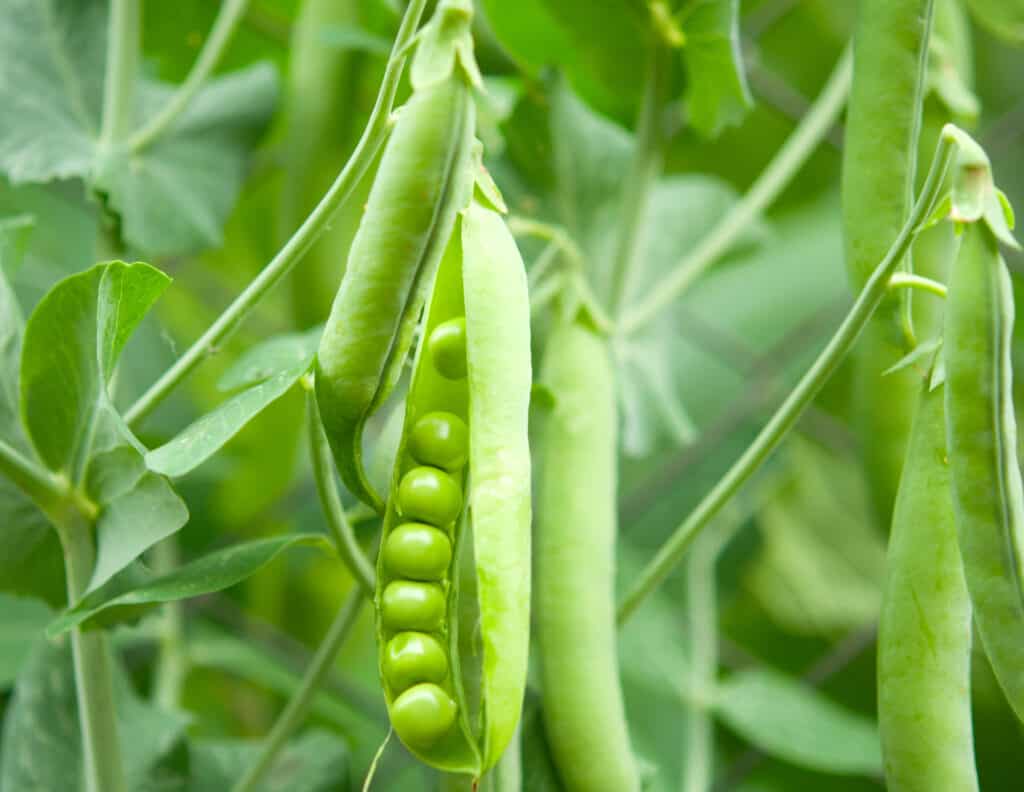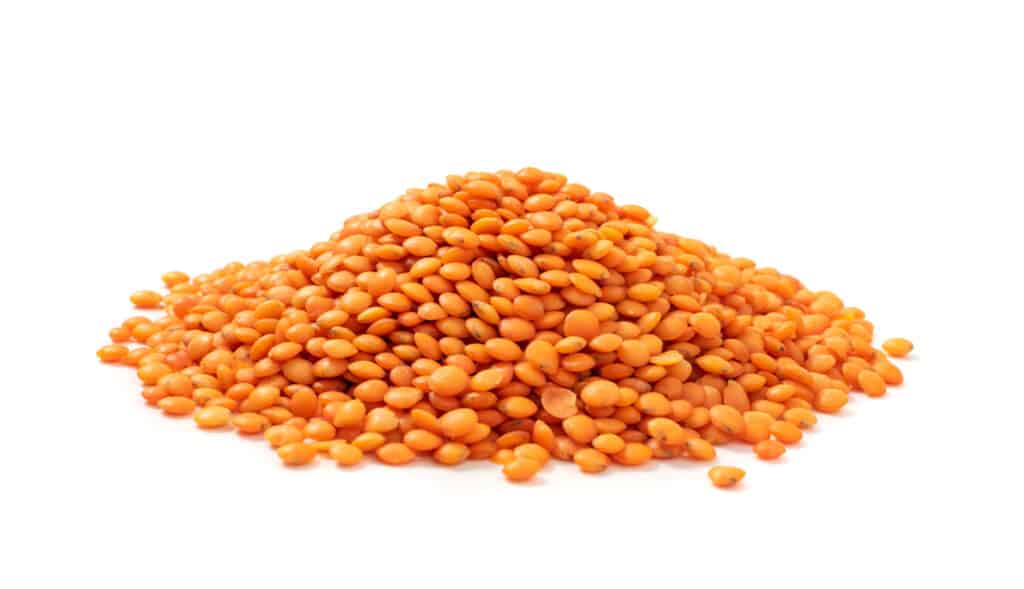Split peas and lentils are two legumes with different nutritional profiles. A cup of lentils is higher in protein, fiber, and iron than the same amount of split peas. Both legumes are good sources of potassium, with lentils providing 772 mg. and split peas containing 750 mg per cup.
Despite their different nutritional profiles, some people use the terms split peas and lentils interchangeably. However, these foods are not interchangeable. So what is the difference between lentils and split peas? Let’s take a closer look at this overview of these two legumes.
Split Peas vs. Lentils: Comparison
| Category | Split Pea | Lentil |
|---|---|---|
| Classification | Legume | Legume |
| Season | Winter | Winter |
| Color | Green or yellow | Brown, black, coral, gold, green, orange |
| Form (Raw) | Dried, peeled, and split | Dried, whole |
| Appearance | Lens or disc | Split spheres |
| Nutritional Value | Split peas are higher in some nutrients, including vitamins A, C, K, and some B vitamins. | Lentils are higher in protein, iron, and fiber. |
Main Differences Between Split Peas and Lentils
Split peas and lentils are both healthy, protein-rich legumes that can be used to make delicious, nutritious, fiber-rich soups and other dishes. Split peas are dried field peas with the skin removed that have been split in half. Lentils, on the other hand, are usually sold whole in the United States. In India, they often have their hulls removed and are split for use in dal, a thick vegetarian gravy that’s served over rice and other dishes.
Here are the main differences between split peas and lentils.
Split Peas vs. Lentils: Plants

Split peas are simply peas that have been dried, had the skins removed, and been split.
©iStock.com/ksena32
Split peas are the dried seeds of the pea, Pisum sativum, that have been dried, peeled, and split in two. These annual plants grow best in temperate areas where the summer doesn’t get too hot and prefer sandy-loam soil that drains well and contains lime and other key organic matter. They’re native to Iran, Iraq, Syria, and Turkey.
Lentils are the edible seeds of Lens culinaris, an annual vine that are commonly grown in Asia, Europe, and North Africa. Lentils are also annuals, but they prefer well-drained, loose soil that’s rich in organic matter and need up to six hours of direct sunlight per day.
Split Pea vs. Lentil: Growing Zones
Split peas are typically grown in the northern latitudes but can also be grown in warmer and milder areas. The growing season for split peas is long, hot, and dry. They can be planted in the early spring and harvested in late fall until they die off during winter. Winter peas can grown in Zones 9 through 11.
Lentils typically grow between 34 degrees North latitude and 46 degrees South latitude. They can tolerate a wide range of temperatures. Therefore, they can be planted from early spring to early fall, depending on your location. They grow best in Zones 5 through 11.

Lentils are legumes that are known for their lens-shaped, edible seeds.
©Leo Pakhomov/Shutterstock.com
Growing Split Peas and Lentils
Planting these two types of legumes in the same growing area will result in the destruction of the lentils. Unlike peas, lentils are deep-rooted legumes, and they require a lot of space to grow to maturity. They need to be planted at a distance that is double the distance between rows.
Split peas take between six and 10 weeks to mature, while lentils require approximately 10 weeks to mature.
Split Peas vs. Lentils: Nutritional Content
A 100-gram serving of cooked lentils contains 30% protein vs. 26% in the same quantity of cooked split peas. Split peas are slightly higher in carbohydrates at 69% compared to 67% for lentils. Both are low-fat foods: split peas 5% and lentils 3%.
Split peas are significantly lower in fats than lentils: 0.4g vs. 0.38g. Split peas are approximately half as high in calories as lentils: 81kcal vs. 116kcal. And split peas contain 5.67g of sugar compared 1.8g for lentils.
Split peas are higher than lentils in vitamins C, B1, B2, B3, and K. Lentils contain far greater amounts of vitamins B5, B6, and folate. Lentils also win out when it comes to tryptophan, threonine, isoleucine, leucine, lysine, phenylalanine, valine, and histidine.

Yellow and green split peas taste the same and have the same nutritional profile.
©iStock.com/Linda Hall
Split Pea vs. Lentil: Cooking Time
You should rinse split peas and lentils and carefully pick out any debris, such as organic matter, sand or tiny pebbles, before cooking.
Split peas take 20 – 25 minutes to cook. Lentils, on the other hand, can take up to 45 minutes. Split peas take less time to cook because their skins have been removed and, as their name implies, they have been split in half.

Red lentils are used extensively in Indian cooking, including the protein-rich vegetarian gravy called dal.
©Ermak Oksana/Shutterstock.com
Split Pea vs. Lentil: Uses
The split pea is commonly used as a staple in many cuisines. It is widely used in Indian and Middle Eastern cooking, including various soups, stews, salads, and dips. It may be added at the beginning of the cooking process or cooked shortly after other vegetables.
Lentils are used extensively in Indian, Middle Eastern, African, and Brazilian cooking in dishes such as stews and casseroles, baked winter vegetable borsch, and minestrone.
Split Peas vs. Lentils: Taste
The split pea’s taste is a bit starchy and they have a mild, creamy texture. Lentils have a “meatier,” earthier flavor with some nutty notes. The natural flavors of both split peas and lentils can be enhanced, or even completely transformed, with herbs and spices, which vary by cuisine and individual cook.
Split Pea vs. Lentil: How to Store
You can store dried split peas and lentils in a cool, dry place for up to two to three years. After five years, their nutritional content will be greatly diminished. Commercially packaged split peas and lentils feature expiration dates.
Split Pea vs. Lentil: Origin
Split peas originated in Asia and were cultivated in the Middle East long before Europeans arrived. The term “split” refers to the unique process of removing the tough hulls from the seeds. The whole pea is harvested while the pods are still green, and the peas are dried and then split open to remove the hulls.
Lentils are native to the Mediterranean region but were grown in Egypt 9,000 years ago. The Greeks wrote about lentils as early as the sixth century B.C., and the Italian poet Dante even mentioned them in one of his works.
In 100 B.C., Chinese emperor Han Nang extensively cultivated lentils for use in soups, stews, and other popular dishes. However, despite their popularity, lentils were not considered a staple food until the 1700s when Dutch traders introduced them to India.
Which Is Best: Split Pea vs. Lentil?
Split peas and lentils are both healthy, high-protein, high-fiber legumes that are rich in nutrients. They are both used extensively in vegetarian cooking around the world. Their nutritional profiles are dramatically different, however, so one should not be substituted for the other. Instead, put both of them into your cooking rotation so you can reap their unique dietary benefits.
Up Next
- 19 Vegetables to Plant in September
- Butter Beans vs. Lima Beans: What’s The Difference?
- 4 Reasons Dogs Can (and Should) Eat Peas
The photo featured at the top of this post is © Ermak Oksana/Shutterstock.com
Sources
- Extension Illinois, Available here: https://extension.illinois.edu/blogs/simply-nutritious-quick-and-delicious/2019-09-27-split-peas-are-they-peas-or-lentils#:~:text=Split%20peas%20are%20a%20member,of%20a%20small%20annual%20plant.
- The Kitchn, Available here: https://www.thekitchn.com/whats-the-difference-between-split-peas-and-lentils-word-of-mouth-214986
- Livestrong, Available here: https://www.livestrong.com/article/416927-difference-between-split-peas-lentils/
- The Daring Kitchen, Available here: https://thedaringkitchen.com/are-split-peas-lentils/
- Food Struct, Available here: https://foodstruct.com/compare/pea-vs-lentil
- Souper Sage, Available here: https://www.soupersage.com/compare-nutrition/peas-vs-lentils#:~:text=Peas%20and%20lentils%20contain%20similar,has%2020.1g%20of%20carbohydrates.
- Bio Web, Available here: http://bioweb.uwlax.edu/bio203/s2009/tarmann_sama/habitat.htm
FAQs (Frequently Asked Questions)
Are lentils the same as split peas and vice versa?
No, they are not interchangeable. They come from two different plants and have completely different nutritional profiles.
Why do cooked split peas form a green ring around the skin? Is it mold?
The green ring that forms on split peas is not mold, it is simply a sign of oxidation. If you discard the skin, few people can taste the difference.
How do you decide when to cook split peas instead of lentils?
Both lentils and split peas are good for soups. One advantage of using split peas for soup is that the soup will retain its consistency even if it is stored in the refrigerator for a few days. This is because split peas absorb water better than lentils do.
Thank you for reading! Have some feedback for us? Contact the AZ Animals editorial team.






